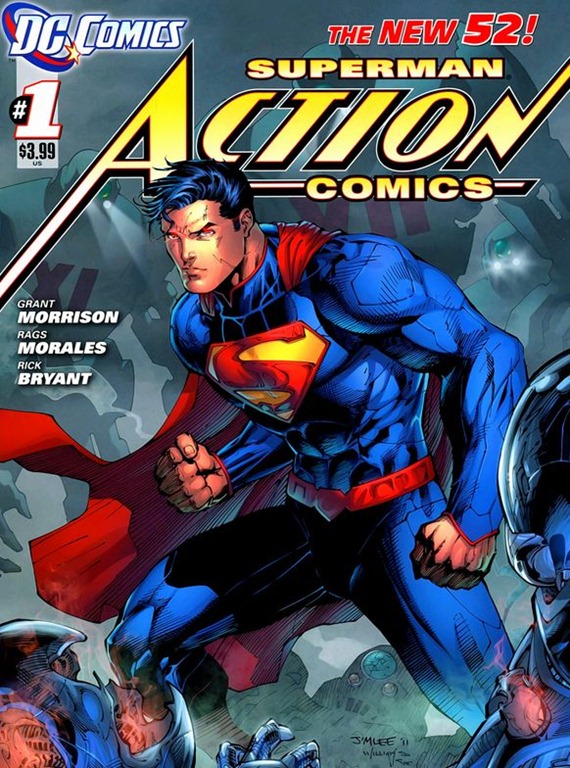Boom! Wham! Pow! The ComiQuad is a brand new column dedicated to the spandex-laden world of comics and superheroes. It goes up each Tuesday and will alternate between comic book reviews and other comic book news. Reviews shall try to be spoiler-free. Zam!
Do you know how to make money off of comic books? If so, please feel free to contact the leaders of the modern comic book industry.
With the New 52 reboot, there’s been heavy discussion about the value of comic books now abruptly starting at Issue #1. The original Action Comics #1 has been auctioned off for prices ranging from several hundred thousand dollars to over a million dollars. Suddenly, there’s a brand new kid in town arrogantly walking around with the moniker of Action Comics #1. What does this mean?

Well, it means that there are two Action Comics #1. It is obvious, however, which one is worth hundreds of thousands of dollars and which is worth hundreds of…cents. Both the date and the lack of distinct 1938 style make that clear. Regardless, both carry around the shiny badge of being “#1.” In time, the newer #1 issues should be of value, right?
Right. Sort of. Being #1 gives you prestige. Being #2 might get you a Wikipedia entry. Same goes for the value of comics. The recent “#1’s” will definitely gain value over several decades. In fact, many comics from the 80’s with peasant numbers like “#382” are worth upwards of several hundred dollars today.
Luckily for anyone in the possession of recent #1’s, there are many tricks of the trade to determining the current and future worth your comics. And that is where you judge a book by its cover.
Cracking the (bar)Code
On the cover of a DC or Marvel comic (other publishers are less consistent), there is a barcode box in a bottom corner. Within that box, there are two barcodes, one small and one large. Above that small barcode is the key to a wealth of information.
Let’s pretend Sally goes to her local comic book store and picks up Action Comics #1 and the number above the small barcode is “00111.” This code will tell her three things.
The first three digits of that number indicate the issue’s number within the entire collection. In this case, “001” tells Sally that her copy of Action Comics is, in fact, issue #1.
The next number in the series, the fourth digit, refers to cover of the issue. In the above example, “1” means that your issue has the primary cover. Frequently, more popular series like Action Comics, Green Lantern, and Batman ship with alternate, less common covers. These covers may feature alternate artists and often only one is printed for every 25 primary covers. Variant covers, the most valuable variety, tend to go for several hundred dollars on eBay because only one variant is printed for every 200 primary covers. Comic store owners will charge more for these covers.

Lastly, the fifth digit tells which printing the comic is. This, for many collectors of #1’s, is an incredibly important number. In the case of popular comics released during the New 52, stores ran out of their current stock and had to re-order from second and third printings. Those copies will be of considerably less value than their first edition counterparts.
Luckily for Sally, her code means that she has a #1 from a first print run! Her comic book could only be more valuable if it had a number like “00121” or “00131,” which would imply she had a special cover. Overall, however, Sally did pretty well.
Get the Red Out
DC Comics has also gone out of their way to add one more visual indicator to their recent #1 issues. Second printings of the first issues have the same cover designs, but feature a universal “red-ified” background. The fifth digit (the printing indicator) will be different, but the fourth digit (the cover indicator) will not.
Comics Clairvoyance
Despite all the cover/barcode hullabaloo, it is important to realize that no one can exactly predict the eventual worth of any single comic book. Condition, cover, printing, and issue number play a major role in the process. A variety of unpredictable factors, however, tend to mess with the formula. Titles like Batman #1 and Action Comics #1, due to their popularity, sold very well; consequently, there are many copies floating around the market. Underestimated but hugely popular titles like Animal Man #1 are incredibly hard to find in first printing edition.
In 30-50 years, these issues are just as likely to be worth thousands of dollars as they are to be worth tens of dollars. Take precaution before you raid your comic book store. The best bet is to buy the comics you are interested in and watch their value progress from there. Worst case scenario: your comic book will be rich in sentimental value that you can share with your kids (or cats).

